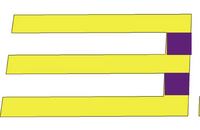jameslast
Newbie
So I want to structure a coplanar waveguide by lithography, VNA - coaxial - picoprobe - coplanar waveguide transition to measure impedance of the waveguide. As signal and ground lines are on one surface, compared to e.g. a cpw without groundplane, one should be able to terminate the waveguide with 50 Ohm at the end on the wafer used for lithography?
I found some hinted ways to do this, e.g. different stub geometries, or an antenna or resistor as terminating load. The last one I know from BNC cables, the 50 Ohm ending caps. The correct stub geometry has probably to be found by something like CST Microwave, Sonnet, HFSS? My CPW consists of 100 nm thick gold, width 15 micron, gap 10 micron, 1-2 mm length, 1-2 GHz.

To find a material able to be deposited accurately with resitivity to yield 50 Ohm for this geometrical demands seems tricky like in the upper right of the picture. The lower left is my guess but probably wrong, causing reflections because of the 90° bended ground lines before ending in the stub, so maybe a tapering like in the lower right has to be designed or an antenna-like small coil?
Is there maybe a easier solution for this on-die termination, maybe to use unbalanced or coupled lines (sorry dont know exact name, basically CPW with 1 signal and 1 ground line). Maybe this is easier to design geometrically a terminating stub/antenna/resistor at the end?
I found some hinted ways to do this, e.g. different stub geometries, or an antenna or resistor as terminating load. The last one I know from BNC cables, the 50 Ohm ending caps. The correct stub geometry has probably to be found by something like CST Microwave, Sonnet, HFSS? My CPW consists of 100 nm thick gold, width 15 micron, gap 10 micron, 1-2 mm length, 1-2 GHz.

To find a material able to be deposited accurately with resitivity to yield 50 Ohm for this geometrical demands seems tricky like in the upper right of the picture. The lower left is my guess but probably wrong, causing reflections because of the 90° bended ground lines before ending in the stub, so maybe a tapering like in the lower right has to be designed or an antenna-like small coil?
Is there maybe a easier solution for this on-die termination, maybe to use unbalanced or coupled lines (sorry dont know exact name, basically CPW with 1 signal and 1 ground line). Maybe this is easier to design geometrically a terminating stub/antenna/resistor at the end?
